
وبلاگ سپهران | Foods | Famous and Delicious Indian Foods: A Flavorful Journey Through the Heart of India
Famous and delicious Indian foods are a flavorful journey through the Heart of India.
India is a land of breathtaking diversity — from languages and landscapes to traditions and, of course, food. Indian cuisine is not just a way of eating; it’s a vibrant reflection of the country’s history, spirituality, and deep-rooted cultural values. Each region has its own culinary soul, shaped by climate, geography, and generations of storytelling through spices. Whether you’re sampling sizzling street food in Mumbai or enjoying a slow-cooked family meal in Lucknow, every bite offers a glimpse into a unique way of life.
Let’s embark on a delicious journey through some of the most iconic and mouthwatering dishes that define the Indian culinary experience.
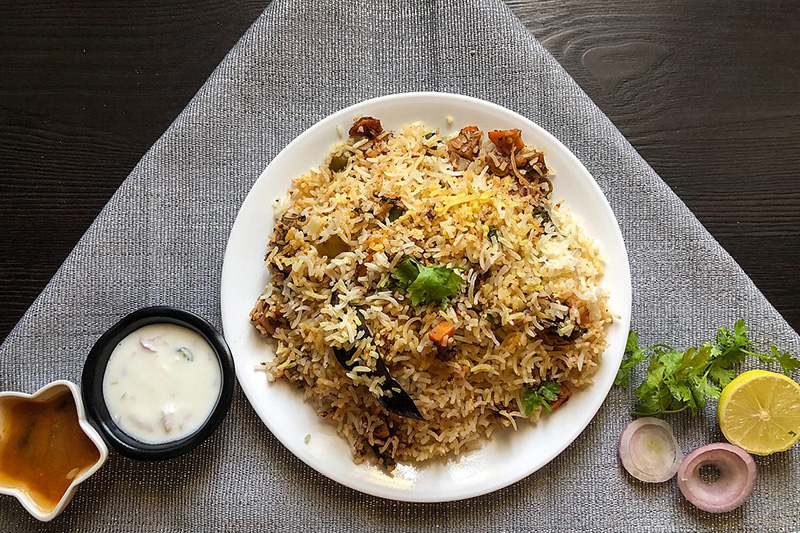
Biryani isn’t just a dish; it’s an emotion. Born in the royal kitchens of the Mughals, Biryani combines tender marinated meat—often chicken, lamb, or goat—with long-grain basmati rice infused with saffron, rose water, and a carefully balanced mix of whole spices. It’s slow-cooked using the “dum” method, where the pot is sealed with dough to trap the steam, allowing the ingredients to meld into one aromatic masterpiece. Biryani is delicious Indian foods.
Every region adds its signature twist: Hyderabad’s version is spicy and bold, Kolkata’s is fragrant and subtle with boiled eggs and potatoes, and Bangalore’s is richly layered and paired with roasted eggplant curry. Served with raita, salan, or pickled onions, Biryani is not just a meal—it’s a festival on a plate.
| How to Prepare | Key Spices & Seasonings |
|---|---|
| Marinate meat (or vegetables) in yogurt and spices. Layer with partially cooked basmati rice, add saffron milk, and cook on low heat (dum style). | Garam masala, saffron, cardamom, cloves, bay leaves, cinnamon, turmeric |
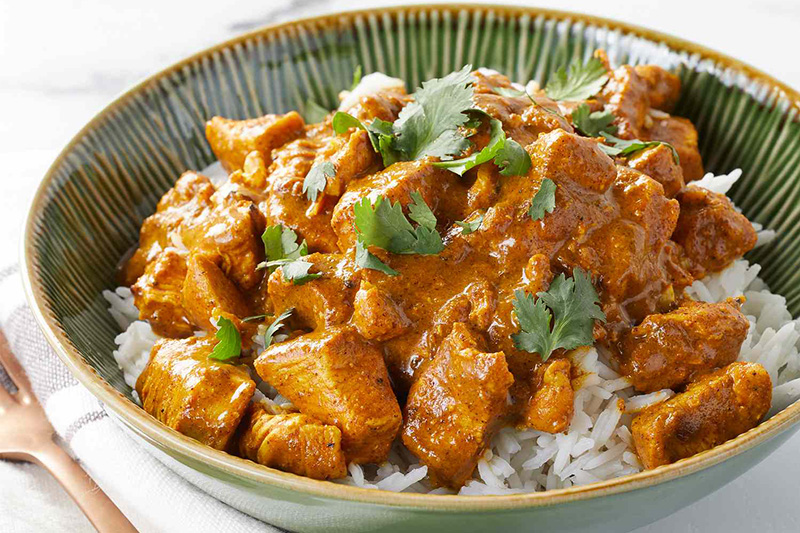
“Curry” is often misunderstood outside India, where it’s seen as a single dish. In truth, curry in India is a vast and colorful universe of gravies and stews. From the coconut milk–based curries of Kerala to the mustard seed–spiced dishes of Bengal, each version reflects its region’s soul.
A curry might be made with yogurt, tomatoes, or tamarind; it may simmer lamb, paneer, or jackfruit. What ties them all together is the technique—tempering spices in hot oil (a process called tadka) to release their essential oils. Curries are the comfort food of Indian homes, passed down from mothers to daughters, full of history and healing. It is one of the delicious Indian foods.
| How to Prepare | Key Spices & Seasonings |
|---|---|
| Sauté onions, garlic, and ginger. Add chopped tomatoes and cook into a base. Add vegetables or meat, simmer with spices and broth or cream. | Turmeric, cumin, coriander, chili powder, garam masala |
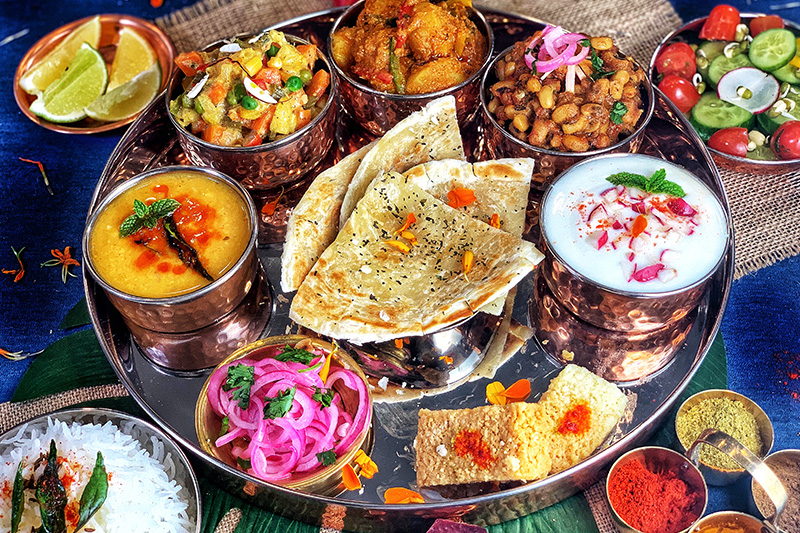
Thali is not just a meal—it’s a cultural experience. It’s a round metal plate with small bowls filled with a variety of items: rice, dal (lentils), vegetable sabzi, spicy pickles, cooling yogurt, roti or puri, a sweet, and sometimes chutneys. Each bite is a new sensation: spicy, sour, salty, sweet, bitter, and astringent—offering perfect Ayurveda balance. It is one of the delicious Indian foods.
Eating a Thali is like listening to an orchestra where every instrument has its moment. It’s also deeply regional: a South Indian thali may include sambar, rasam, and coconut chutney, while a Rajasthani thali might offer gatte ki sabzi, kadhi, and bajra roti. It’s India’s culinary diversity, distilled into one plate.
| How to Prepare | Key Spices & Seasonings |
|---|---|
| Assemble a plate with small portions of various Indian dishes like dal, sabzi, rice, bread, yogurt, and pickle. | Varies by region: turmeric, mustard seeds, asafoetida, fenugreek, curry leaves |
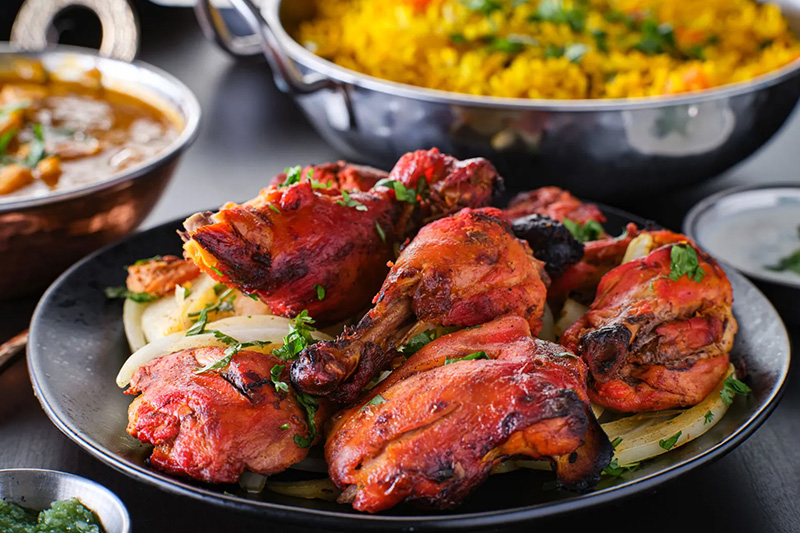
Tandoori Chicken is marinated in yogurt, lemon juice, garlic, ginger, and a blend of spices like garam masala, paprika, and turmeric. Then it’s roasted in a clay oven called a tandoor, which gives it its smoky flavor and charred exterior. The result is succulent meat with a fiery red hue—crispy outside, juicy inside. It is one of the delicious Indian foods.
Originally from Punjab, this dish exploded in popularity post-independence and is now a symbol of Indian cuisine around the world. It’s usually served with lemon wedges, mint chutney, and rings of raw onion. The combination of tang, spice, and smoke makes it utterly unforgettable.
| How to Prepare | Key Spices & Seasonings |
|---|---|
| Marinate chicken in yogurt, lemon juice, and spices. Grill in a tandoor or oven until smoky and charred. | Tandoori masala, paprika, cayenne, garlic, ginger, cumin |

Some say it was born in Britain, others claim its roots in Punjab—but no matter the origin, Chicken Tikka Masala has earned global fame. Boneless chicken pieces are marinated in yogurt and spices, grilled until lightly charred, then simmered in a rich, tomato-based cream sauce.
The sauce is mildly spiced and irresistibly creamy, making it accessible even to those new to Indian food. It pairs beautifully with naan or basmati rice. For many, this dish is the gateway to Indian cuisine; it’s bold but not overpowering, flavorful yet familiar.
| How to Prepare | Key Spices & Seasonings |
|---|---|
| Grill marinated chicken tikka pieces. Simmer in creamy tomato-based sauce with aromatic spices. | Garam masala, paprika, turmeric, cumin, fenugreek leaves |
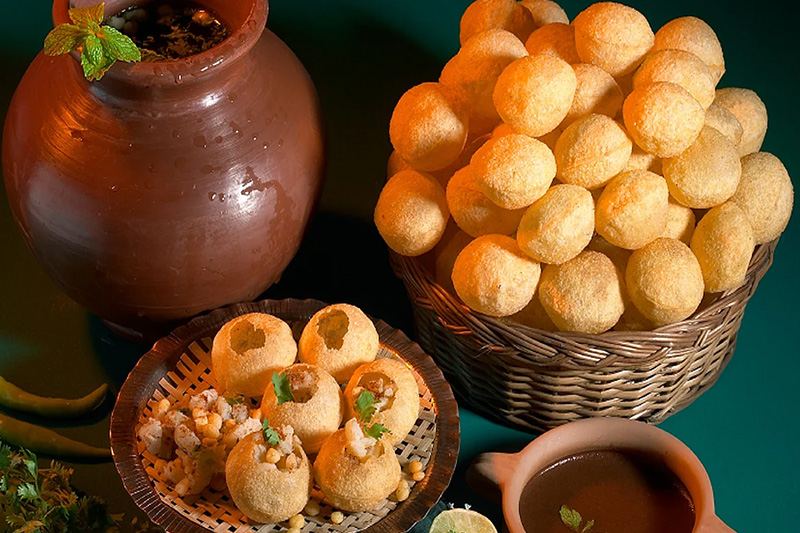
Imagine standing at a street cart as the vendor expertly cracks open a tiny, hollow puri, fills it with spiced mashed potatoes and chickpeas, dunks it in chilled tamarind-mint water, and hands it to you. You pop it in your mouth—and there it is; crunch, chill, tang, spice, and joy, all at once.
Known as Golgappa in the north or Puchka in Bengal, Panipuri is a street food icon. It’s not just about the taste—it’s about the experience, the rhythm, the anticipation. One is never enough. It’s fast, fun, and deliciously addictive. Panipuri is one of the delicious Indian foods.
| How to Prepare | Key Spices & Seasonings |
|---|---|
| Fill crisp puri shells with spiced potato or chickpeas. Add tangy, spicy tamarind water before serving. | Chaat masala, black salt, mint, cumin, tamarind, chili |
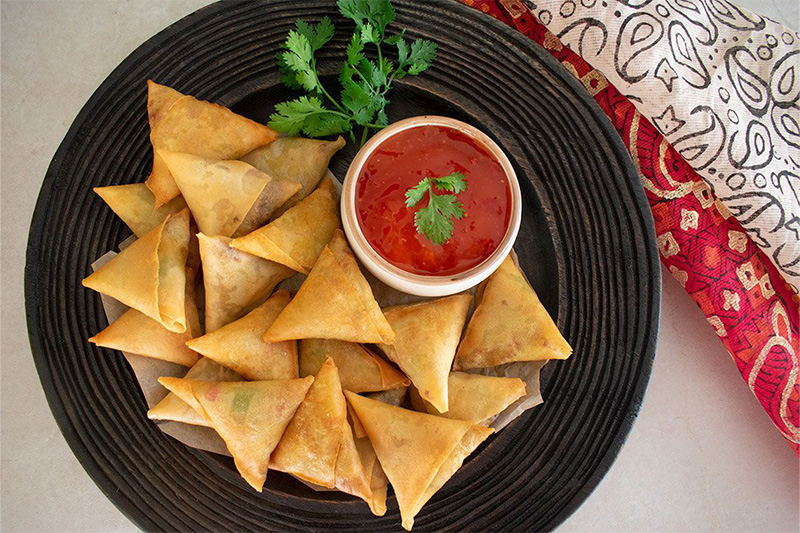
These crispy, deep-fried pastries have become global ambassadors of Indian snacks. Shaped like triangles, samosas are stuffed with a savory mix of mashed potatoes, peas, and spices—or sometimes minced meat, cheese, or lentils. The dough is flaky, the filling aromatic, and the dipping sauces (mint and tamarind) elevate each bite.
They’re served at festivals, tea-time, train stations, and weddings. Every bite brings warmth, crunch, and a hint of nostalgia. In India, life’s small joys often begin with a samosa and a cup of chai.
| How to Prepare | Key Spices & Seasonings |
|---|---|
| Make dough, stuff with spiced potato filling, and deep-fry until golden and crispy. | Cumin seeds, coriander, garam masala, green chili, fennel seeds |
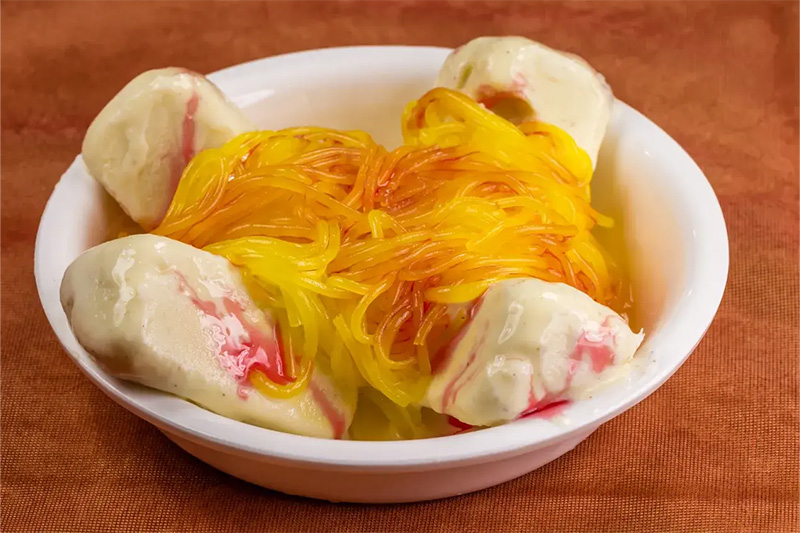
Falooda is a layered dessert that looks like art in a glass and is a delicious Indian foods. It starts with rose syrup, followed by soaked vermicelli noodles, sweet basil seeds (sabja), cold milk, a scoop of ice cream, and a sprinkle of nuts or fruit. Sometimes jelly cubes or kulfi (Indian ice cream) are added.
It originated in Persia and traveled to India with the Mughals, where it became a royal indulgence. Today, it’s a popular street-side dessert during hot summer months. With its rich texture and cooling layers, Falooda is like drinking a sweet, fragrant memory.
| How to Prepare | Key Spices & Seasonings |
|---|---|
| Layer soaked basil seeds, vermicelli, rose syrup, milk, jelly, and ice cream in a glass. | Rose syrup, cardamom (optional), saffron (optional) |
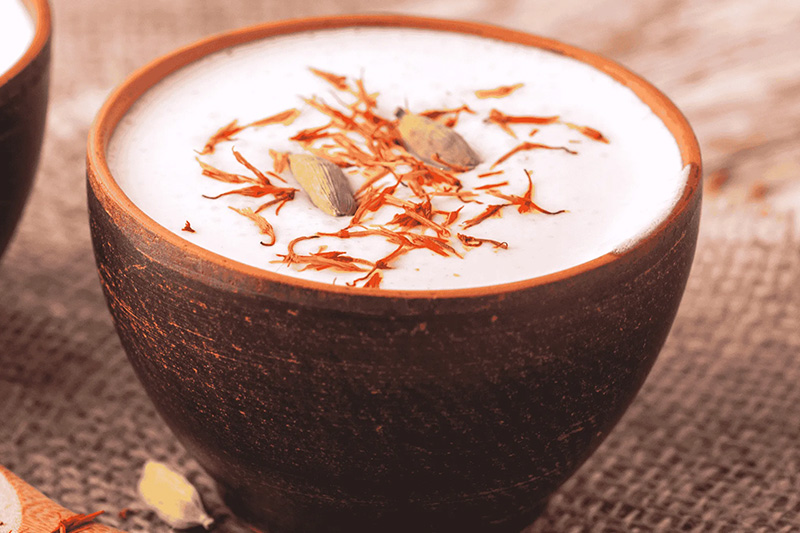
Lassi is more than a drink—it’s a cultural symbol that stretches back thousands of years. Made with yogurt blended with water and sometimes milk, it can be sweet, salty, or even spicy. A sweet lassi might include sugar, rosewater, cardamom, or mango pulp, while a salty one may feature cumin, black salt, and mint.
Served chilled in a clay cup or steel tumbler, lassi cools the body in India’s scorching summers and aids digestion after heavy meals. It’s a rural staple and an urban favorite, a drink of farmers and royals alike. One sip, and the soothing, creamy texture immediately calms your senses.
| How to Prepare | Key Spices & Seasonings |
|---|---|
| Blend yogurt with water or milk. Add sugar (for sweet) or salt and cumin (for salty). Serve chilled. | Cardamom, rose water, saffron, roasted cumin seeds (for salty) |
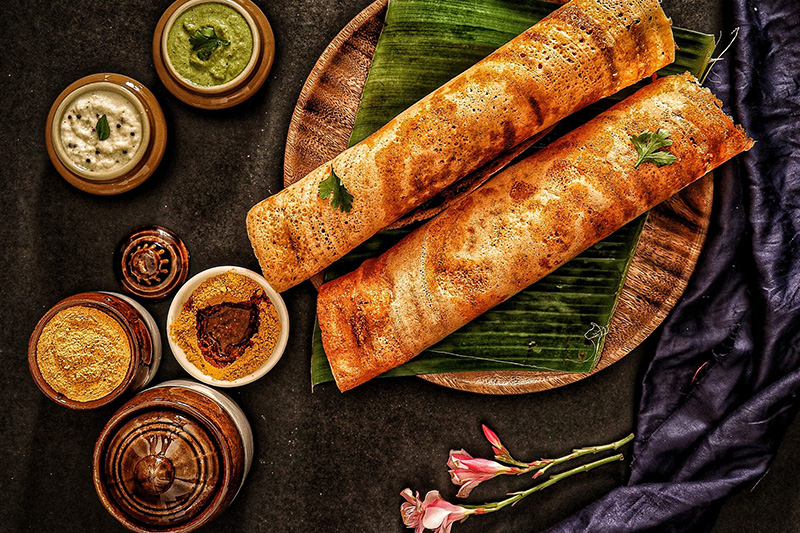
Dosa is a crisp, paper-thin crepe made from fermented rice and urad dal (black lentil) batter. Golden brown and slightly tangy, it’s griddled to perfection and often rolled around a spicy potato filling. Accompanied by coconut chutney and sambar (a tangy lentil soup), dosa is a breakfast essential across South India.
But dosa isn’t limited to mornings. In busy cities like Chennai and Bangalore, it’s served all day in darshinis and street stalls. The variety is endless—masala dosa, rava dosa, onion dosa, cheese dosa—each with its loyal fan base. Eating dosa with your hands, tearing off crunchy bits, and dipping them in chutney is a sensory joy. Dosa is delicious Indian foods.
| How to Prepare | Key Spices & Seasonings |
|---|---|
| Ferment a rice and urad dal batter. Pour thin layer on a hot griddle and cook until crispy. | Mustard seeds, curry leaves, fenugreek seeds (in batter or filling) |
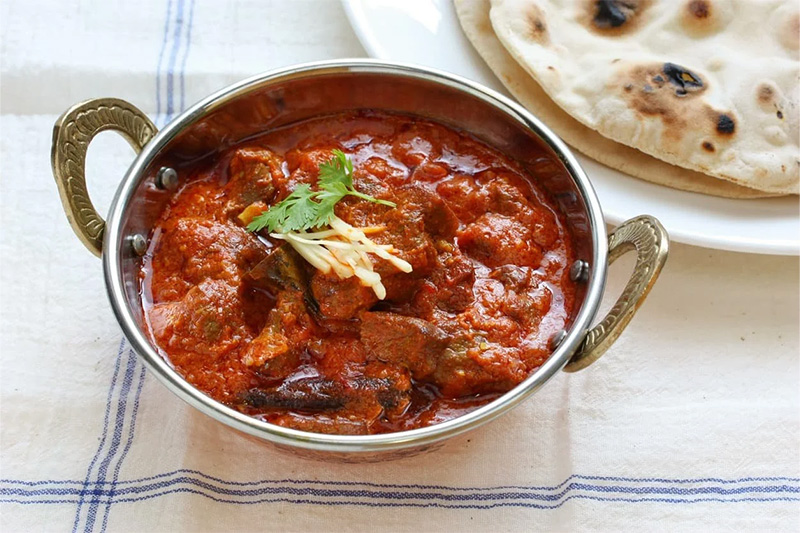
Hailing from the cold valleys of Kashmir, Rogan Josh is a robust lamb curry characterized by its deep red color and aromatic richness. The meat is slow-cooked in a blend of yogurt, caramelized onions, garlic, and Kashmiri chili—giving it heat without overwhelming the palate.
The name comes from “rogan” (oil) and “josh” (heat or passion), and the dish lives up to that name—passionate, intense, warming. Traditionally eaten with naan or saffron rice, Rogan Josh is a winter favorite that brings spice and soul to the table.
| How to Prepare | Key Spices & Seasonings |
|---|---|
| Slow-cook lamb in spiced yogurt gravy until tender and rich. | Kashmiri chili, cardamom, cloves, cinnamon, fennel, ginger powder |
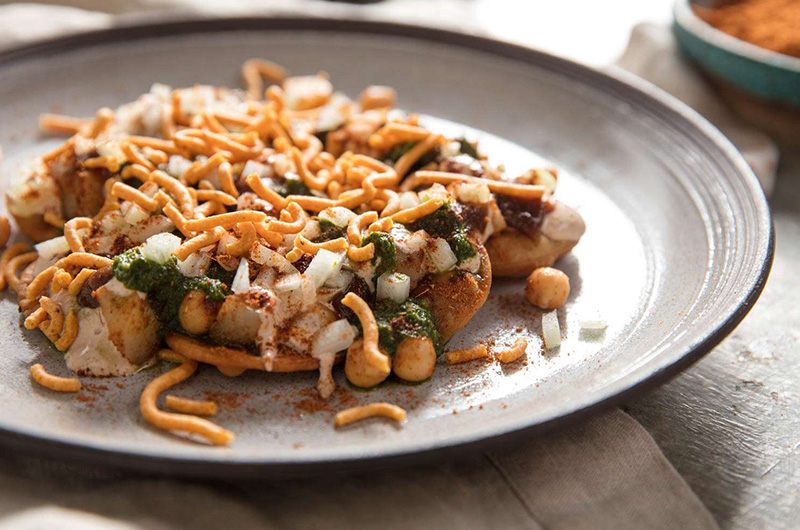
“Chaat” means “to lick,” and that’s exactly what you’ll want to do after tasting this zesty street snack. Chaat combines crunchy fried dough, boiled potatoes, chickpeas, yogurt, tangy tamarind chutney, fresh herbs, and spice blends like chaat masala. So, Chaat is a delicious Indian foods.
From Delhi’s Aloo Tikki Chaat to Mumbai’s Sev Puri and Kolkata Papdi Chaat, each region has its playful spin. It’s messy, it’s loud, and it’s bursting with contrast: crispy and creamy, spicy and sweet, hot and cold. Chaat is not refined—it’s chaotic magic, meant to be eaten with your fingers and a big grin.
| How to Prepare | Key Spices & Seasonings |
|---|---|
| Mix fried dough, chickpeas, potatoes, yogurt, chutneys, and spices. Serve immediately. | Chaat masala, cumin powder, chili powder, black salt |
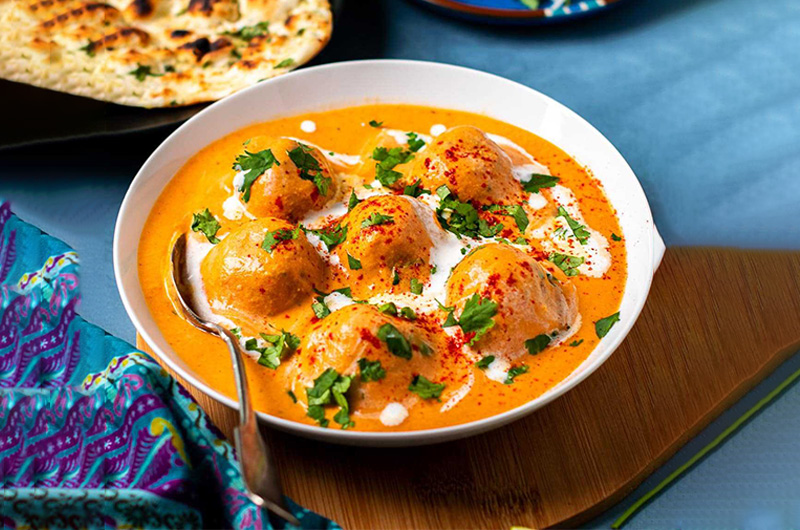
Malai Kofta is the vegetarian answer to meatballs, and it’s decadent. The “koftas” are deep-fried balls made from mashed potatoes, paneer (Indian cottage cheese), nuts, and raisins, giving them a subtle sweetness and buttery texture. They’re gently placed in a luscious cream-and-tomato sauce lightly spiced with cardamom, cinnamon, and saffron.
This dish has royal roots—once served in Mughal courts—and remains a favorite in weddings and celebrations. Best enjoyed with naan or jeera rice, Malai Kofta is soft, rich, and comforting—a true treat for vegetarians and meat-eaters alike.
| How to Prepare | Key Spices & Seasonings |
|---|---|
| Fry balls made of paneer, potato, and nuts. Serve in a creamy, spiced tomato sauce. | Cardamom, garam masala, cumin, nutmeg, saffron |
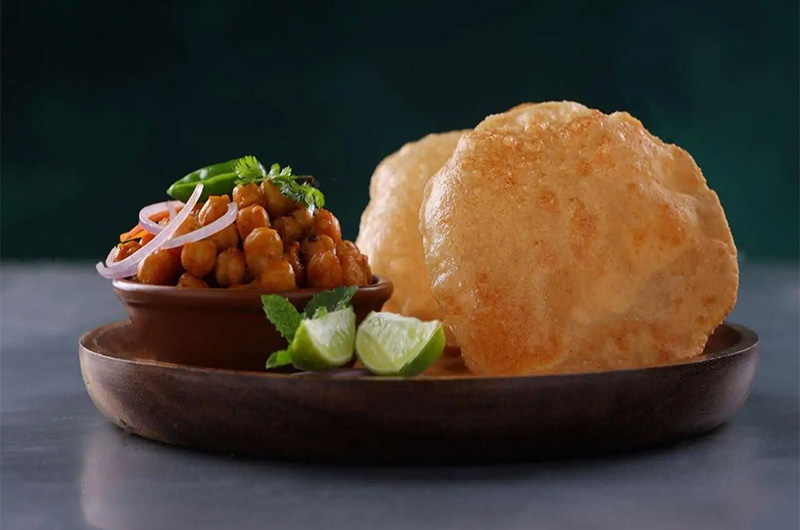
Chole bhature (also called Chana Masala) is a staple North Indian chickpea curry made with tomatoes, onions, garlic, ginger, and a bold mix of spices like garam masala, clove, bay leaf, and black cardamom. It’s thick, savory, and perfect for soaking up with bhature (deep-fried bread) or plain basmati rice. It’s one of the delicious Indian foods.
Chole bhature isn’t fancy, but it’s deeply satisfying. It’s the dish of Punjabi dhabas, wedding buffets, and Sunday brunches. Packed with protein, it’s both nourishing and crave-worthy—a dish that turns humble chickpeas into something unforgettable.
| How to Prepare | Key Spices & Seasonings |
|---|---|
| Cook chickpeas in spiced tomato gravy. Serve with deep-fried bhature (leavened bread). | Amchur (dry mango), anardana, turmeric, cumin, black cardamom |
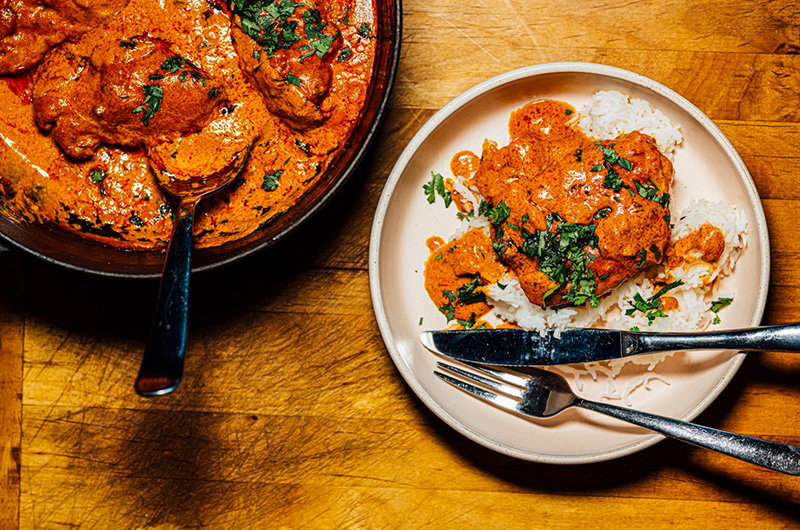
No list is complete without Butter Chicken, known in India as Murgh Makhani. Originating in Delhi, it was created by accident when leftover chicken tikka was tossed into a creamy tomato gravy rich in butter and cream. The result? A dish so universally loved that it became a global ambassador of Indian food.
The chicken is marinated, grilled, and then simmered in a velvety sauce with subtle spices and a touch of sweetness. It’s not fiery—just luxuriously flavorful. Eaten with soft naan or jeera rice, it’s often the first Indian dish tried by foreigners, and rarely the last.
| How to Prepare | Key Spices & Seasonings |
|---|---|
| Cook marinated grilled chicken in a buttery, creamy tomato sauce. | Fenugreek leaves, garam masala, cardamom, cumin, chili powder |
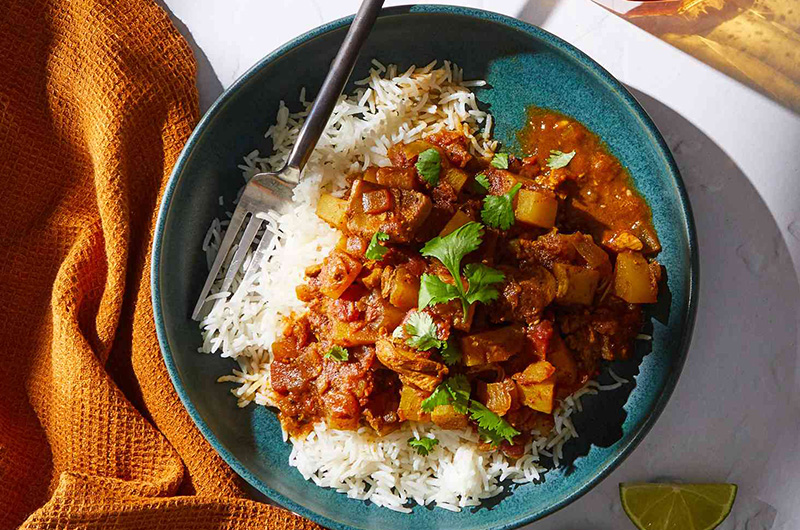
Vindaloo came to India with the Portuguese, and the Goans made it their own. Originally made with pork, vinegar, garlic, and wine, Indian cooks swapped the wine for palm vinegar and added chili, cumin, and cinnamon. The result is an incredibly spicy, tangy, and bold curry.
Vindaloo is not for the faint of heart. It’s a dish that demands attention—and milk on the side! While traditionally pork-based, chicken and lamb versions are common too. Spicy food lovers swear by it, and its fiery reputation travels ahead of it. It’s famous and delicious Indian foods.
| How to Prepare | Key Spices & Seasonings |
|---|---|
| Marinate meat in vinegar, garlic, and spices. Cook slowly in a spicy-tangy curry. | Vinegar, paprika, cinnamon, chili, cumin, mustard seeds |
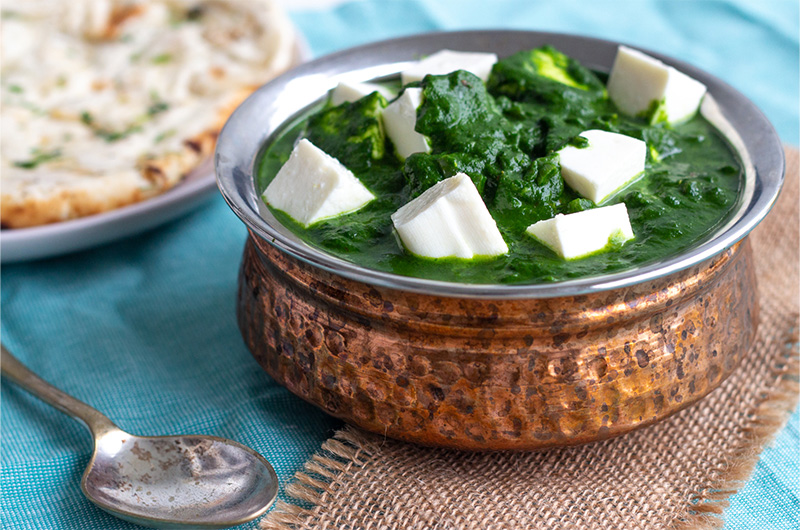
Palak Paneer is a wholesome, vibrant dish where fresh spinach is pureed and cooked with mild spices, garlic, ginger, and cubes of soft paneer cheese. It’s comforting and nutritious, with a deep green hue that’s as beautiful as it is healthy.
It’s popular in vegetarian households and North Indian restaurants around the world. Pair it with roti, naan, or rice—it always delivers. It’s the perfect example of how Indian cuisine can make simple vegetables taste extraordinary.
| How to Prepare | Key Spices & Seasonings |
|---|---|
| Puree sautéed spinach and cook with paneer cubes in a mildly spiced sauce. | Cumin, garlic, garam masala, turmeric, green chili |
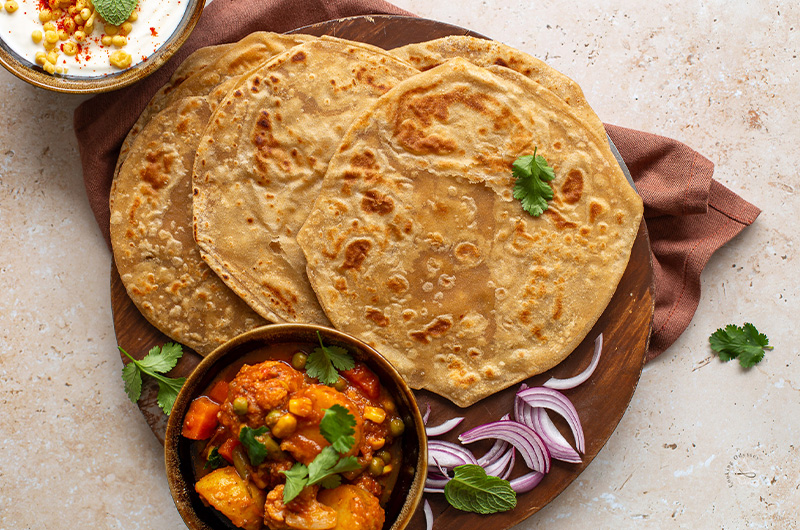
Paratha is the soul of North Indian breakfasts. This flaky, layered flatbread is often stuffed with fillings like spiced mashed potatoes (aloo paratha), cauliflower, paneer, or even minced meat. It’s pan-fried with ghee or oil until golden and crispy.
Served with a dollop of butter, a side of pickle, and a bowl of yogurt or chutney, parathas are deeply comforting. Many Indian children grow up eating their mother’s handmade parathas, rolled out with love and perfectly browned. It’s more than food—it’s nostalgia in every bite.
| How to Prepare | Key Spices & Seasonings |
|---|---|
| Stuff dough with spiced fillings (like potato or paneer), roll, and pan-fry in ghee or oil. | Carom seeds, chili flakes, coriander, cumin |
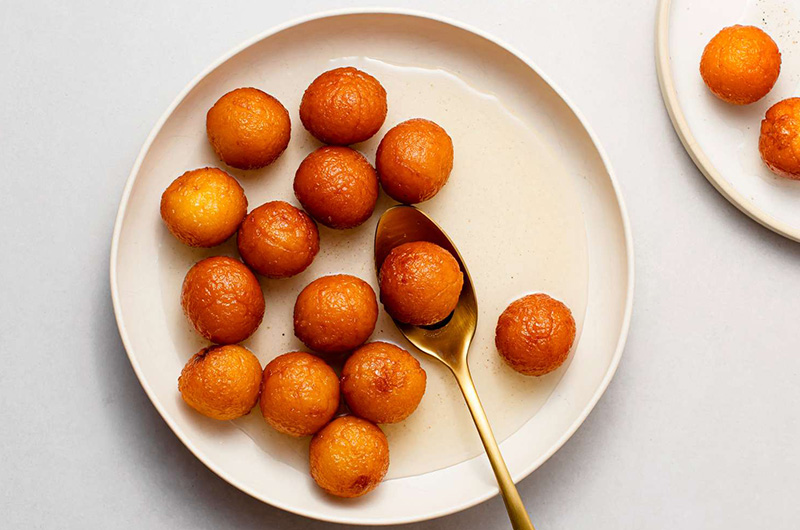
These golden-brown balls of bliss are made from khoya (milk solids), deep-fried until perfectly crisp on the outside, then soaked in fragrant sugar syrup flavored with rose water, cardamom, and saffron. Served warm or cold, Gulab Jamun melts in your mouth and floods your senses with sweetness.
They appear at every celebration—weddings, birthdays, religious festivals—and are often the first dessert to vanish from the table. Soft, syrupy, and seductive, Gulab Jamun is the final note in the song of Indian cuisine—a note that lingers, long after the meal is over. This cuisine is delicious Indian foods.
| How to Prepare | Key Spices & Seasonings |
|---|---|
| Make dough from milk solids, shape into balls, fry, and soak in sugar syrup with rose water. | Cardamom, rose water, saffron |
Indian cuisine isn’t just food—it’s identity, history, ritual, and joy. Every dish carries with it generations of stories, influences from across borders, and the creativity of millions of hands and hearts. Whether you’re devouring a spicy street snack or savoring a royal curry, you’re not just eating—you’re experiencing a culture in motion.
So the next time you try one of these legendary Indian dishes, pause for a moment. Close your eyes. Taste the spice, the sweetness, the care, and the centuries of tradition behind every bite.